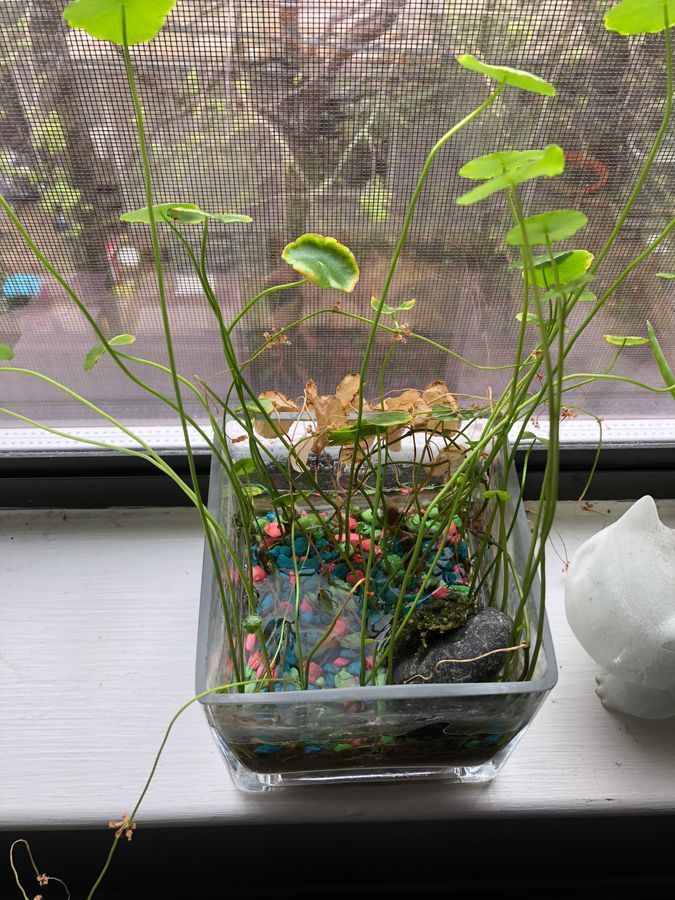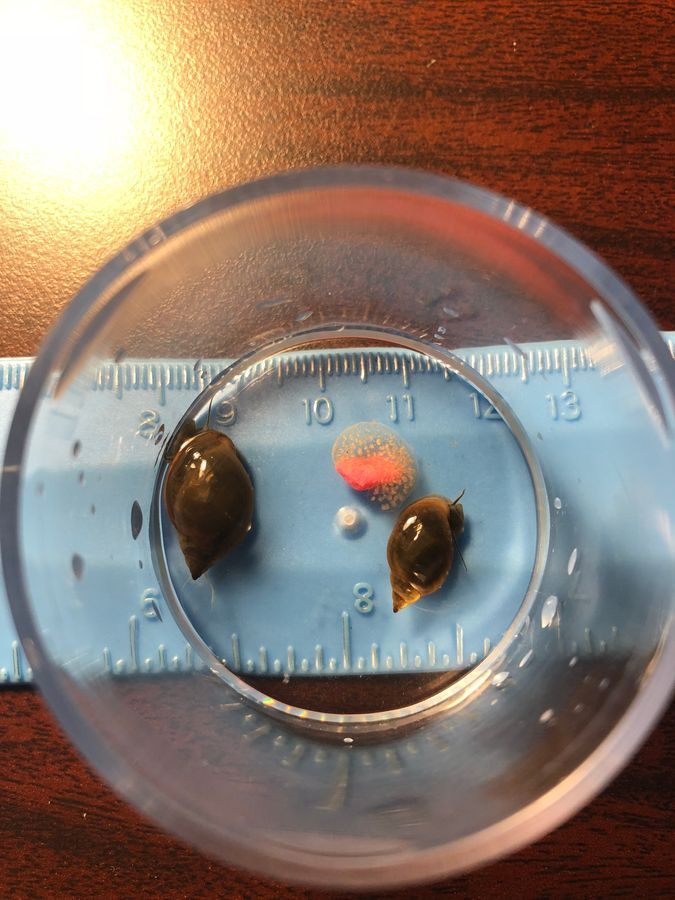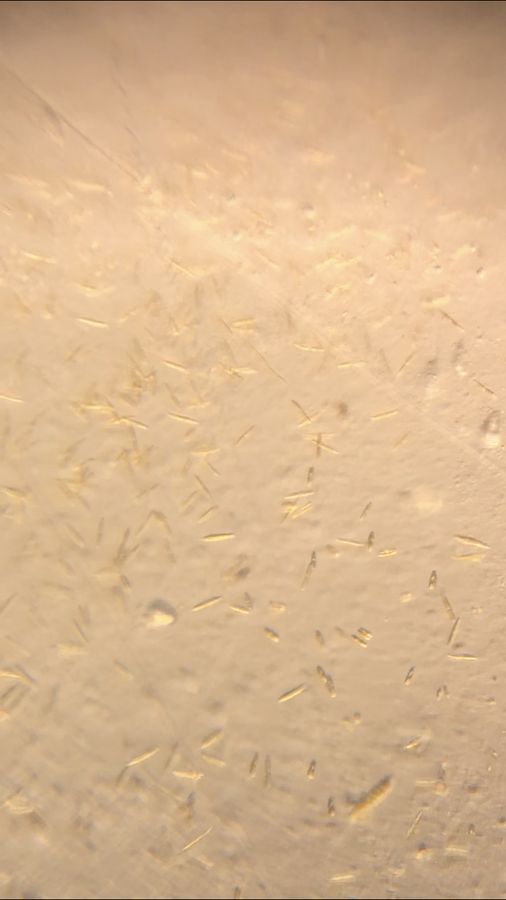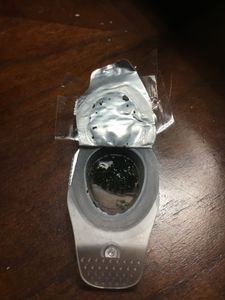Snail babies (and friends!)
 Mar 20, 2018 • 12:05 PM UTC
Mar 20, 2018 • 12:05 PM UTC Unknown Location
Unknown Location 140x Magnification
140x Magnification Microorganisms
Microorganisms
DaisyOfDoom
Learn about the author...
2posts
6comments
1locations

Awhile back I decided to adopt a couple pond snails because my water lily pot had been getting a little messy. They took to the pot immediately, munching away at any dead leaves and cleaning the glass. It seems they may have adapted to the pot a little too well as when I returned to my dorm from break I found several egg sacks, probably containing somewhere near a hundred eggs in total. I’m not ready to be a grandma just yet and I don’t think the pot could support much more than a couple snails at once so I am planning on releasing the egg sacks to the stream their parents came from.
But I couldn’t keep from wondering what they might look like up close…
Methods:
I’m using a similar setup to the spacer wet mount slide I had used previously but was more precise with the spacer this time (it seems to have paid off as water leaks less now). Instead of only putting three pieces of tape I put four and took care that there was as little gap/overlap with the tape as possible. Because I was afraid of crushing the eggs I decided to use a square of a sandwich bag as my slide cover and taped it down at all four sides. In case I needed to top off the water at any point I stuck a small piece of tape facing the opposite direction on one of the pieces of tape holding the cover down to serve as an “easy-lift tab”.
Next was the tricky part: getting the sample. The egg sack was a lot harder to separate than I had anticipated. What seemed to work well for me was using a piece of sturdy clear plastic (the kind you find on packaging) and a mechanical pencil. I used the plastic to press down on the sack where I wanted it seperated. Having it clear is helpful so you can see if you’re in danger of crushing any eggs and can count how many eggs you’ve separated. Pressing down with the plastic was not enough to slice through so I used the lead on my mechanical pencil like a knife, running it along the edge of the plastic until it cut through the sack. Then I pipetted the slice onto my slide with a small bit of water.
But I couldn’t keep from wondering what they might look like up close…
Methods:
I’m using a similar setup to the spacer wet mount slide I had used previously but was more precise with the spacer this time (it seems to have paid off as water leaks less now). Instead of only putting three pieces of tape I put four and took care that there was as little gap/overlap with the tape as possible. Because I was afraid of crushing the eggs I decided to use a square of a sandwich bag as my slide cover and taped it down at all four sides. In case I needed to top off the water at any point I stuck a small piece of tape facing the opposite direction on one of the pieces of tape holding the cover down to serve as an “easy-lift tab”.
Next was the tricky part: getting the sample. The egg sack was a lot harder to separate than I had anticipated. What seemed to work well for me was using a piece of sturdy clear plastic (the kind you find on packaging) and a mechanical pencil. I used the plastic to press down on the sack where I wanted it seperated. Having it clear is helpful so you can see if you’re in danger of crushing any eggs and can count how many eggs you’ve separated. Pressing down with the plastic was not enough to slice through so I used the lead on my mechanical pencil like a knife, running it along the edge of the plastic until it cut through the sack. Then I pipetted the slice onto my slide with a small bit of water.

Proud parents and egg sack (anchored to gravel)

Slicing the egg sack Observations:
Immediately I noticed that I had inadvertently collected more than just the eggs. How exciting!
There were some really fast little creatures swirling around that I have tentatively labeled ciliates but I wouldn’t know much past that. Some seemed to be larger/slower than others so I think there may even be a few types of them in there. The egg sack is sure to be nutrient rich so they are probably having a great time mooching off of the snails.
Then there were the eggs (around 0:32 in the video below). I sectioned off five (I had been aiming for two but it was hard to separate any less than what I got) and unfortunately some fared better than others in the transfer so it was nice to have duplicates. This particular baby snail was quite active. You can see its heart beating from inside the shell and its little eye spots and eye stalks are quite prominent. I’ll admit I don’t know enough about snail anatomy to identify anything else but you can see pretty clearly through the shell because its so small. The one thing I did know to look for from watching the parents skim along the glass was the radula but it seemed to not be visible even when the snail had its mouth right against the front of the egg.
(Disclaimer about this video, I do start fumbling with the focus a bit, haha. I’m only looking around until about 2:00. After that I’m trying — and failing- – to get a dark field view of everything)
Immediately I noticed that I had inadvertently collected more than just the eggs. How exciting!
There were some really fast little creatures swirling around that I have tentatively labeled ciliates but I wouldn’t know much past that. Some seemed to be larger/slower than others so I think there may even be a few types of them in there. The egg sack is sure to be nutrient rich so they are probably having a great time mooching off of the snails.
Then there were the eggs (around 0:32 in the video below). I sectioned off five (I had been aiming for two but it was hard to separate any less than what I got) and unfortunately some fared better than others in the transfer so it was nice to have duplicates. This particular baby snail was quite active. You can see its heart beating from inside the shell and its little eye spots and eye stalks are quite prominent. I’ll admit I don’t know enough about snail anatomy to identify anything else but you can see pretty clearly through the shell because its so small. The one thing I did know to look for from watching the parents skim along the glass was the radula but it seemed to not be visible even when the snail had its mouth right against the front of the egg.
(Disclaimer about this video, I do start fumbling with the focus a bit, haha. I’m only looking around until about 2:00. After that I’m trying — and failing- – to get a dark field view of everything)
The last thing I found in this slide are what I believe to be diatoms. They were all rod shaped but some seemed to be a single rod while others seem to be bisected along their length. If they were moving at all it was too slow to notice. Their video is the one below but if you look closely around 1:10 in the video above you can see a few little rod shapes under the egg.

Diatoms?
(Sorry this is such a long post, I was excited to share. Here’s another baby snail to make up for it!)
(Sorry this is such a long post, I was excited to share. Here’s another baby snail to make up for it!)
Sign in to commentNobody has commented yet... Share your thoughts with the author and start the discussion!

 0 Applause
0 Applause 0 Comments
0 Comments